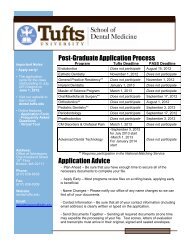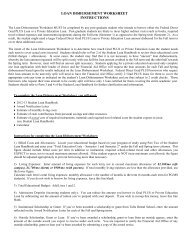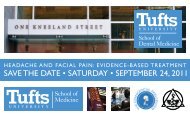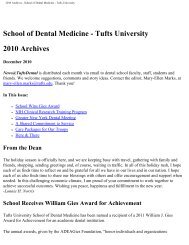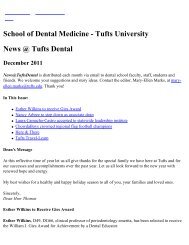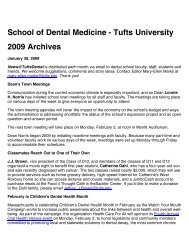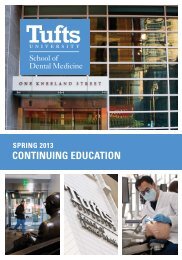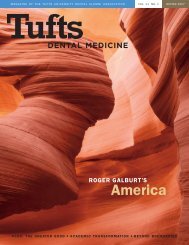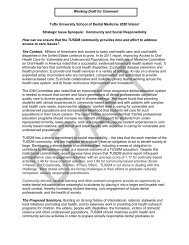Spring 2013 - Tufts University School of Dental Medicine
Spring 2013 - Tufts University School of Dental Medicine
Spring 2013 - Tufts University School of Dental Medicine
Create successful ePaper yourself
Turn your PDF publications into a flip-book with our unique Google optimized e-Paper software.
word <strong>of</strong> mouth<br />
a scan <strong>of</strong> people, places & events<br />
Good Zzzzzs<br />
Mexican students tap into <strong>Tufts</strong>’ dental sleep medicine curriculum<br />
by Helene Ragovin<br />
he field <strong>of</strong> dental sleep medicine was barely out <strong>of</strong> its<br />
infancy when <strong>Tufts</strong> faculty realized the importance <strong>of</strong> training<br />
students to screen, diagnose and treat sleep disorders. In 2009,<br />
the school became the first in the U.S. to incorporate dental<br />
sleep medicine into its curriculum.<br />
But Americans aren’t the only ones whose nights are upended by conditions<br />
such as obstructive sleep apnea, which not only deprive their sufferers <strong>of</strong><br />
much-needed rest but pose significant health risks. So when the <strong>Tufts</strong>-trained<br />
dean <strong>of</strong> a Mexican dental school realized his country could benefit from dentists<br />
with sleep medicine expertise, he reached out to Boston. The result is a<br />
collaboration between <strong>Tufts</strong> <strong>School</strong> <strong>of</strong> <strong>Dental</strong> <strong>Medicine</strong> and the <strong>University</strong> <strong>of</strong><br />
Monterrey (UDEM) that allows students in Mexico to take the <strong>Tufts</strong> class in<br />
dental sleep medicine using distance-learning technology.<br />
“I knew that I had to bring something that would have an impact for our<br />
community,” says Hector Martinez, DG08, dean <strong>of</strong> the UDEM dental school.<br />
“So I turned right back to <strong>Tufts</strong> and asked for help to develop this program.”<br />
The UDEM dental sleep medicine program, now in its second year, is the first<br />
<strong>of</strong> its kind in Latin America.<br />
The course is taught by Leopoldo Correa,<br />
DG11, an associate pr<strong>of</strong>essor <strong>of</strong> diagnosis<br />
and health promotion and head <strong>of</strong> the dental<br />
sleep medicine section at <strong>Tufts</strong>’ Crani<strong>of</strong>acial<br />
Pain, Headache and Sleep Center. UDEM<br />
associate pr<strong>of</strong>essor Hector Cuellar provides<br />
hands-on instruction on his end in Mexico.<br />
With a generation <strong>of</strong> students accustomed<br />
to using Skype and Facetime, the virtual<br />
attendance <strong>of</strong> the Mexican students is fairly<br />
easy to handle, Correa says.<br />
The 24 UDEM students are in their final<br />
year <strong>of</strong> a five-year dental program, all specializing<br />
in a track known as growth and<br />
development. UDEM is a bilingual university,<br />
and the students are tested to assure<br />
their fluency in English.<br />
The prevalence <strong>of</strong> sleep disorders in Latin<br />
America has not been measured extensively,<br />
but a 2008 study in the Journal <strong>of</strong> Clinical<br />
Sleep <strong>Medicine</strong> that examined sleep issues<br />
in four Latin American cities, including<br />
Mexico City, found a “high prevalence <strong>of</strong><br />
sleep-related symptoms and undiagnosed<br />
obstructive sleep apnea,” ranging from 2.9<br />
percent to 23.5 percent <strong>of</strong> the study subjects.<br />
In the U.S., it’s estimated at least 40 million<br />
people have some sort <strong>of</strong> sleep disorder,<br />
and up to 5 percent <strong>of</strong> the population may<br />
have obstructive sleep apnea, in which the<br />
airways consistently become blocked during<br />
sleep. The result, in addition to loud<br />
snoring or gasping, can be sleep that is disrupted<br />
anywhere from a few times to several<br />
hundred times a night. Along with daytime<br />
sleepiness, the periodic lack <strong>of</strong> oxygen can<br />
create a risk for cardiovascular conditions,<br />
such as high blood pressure or stroke, as<br />
well as diabetes and depression. The firstline<br />
treatment is usually a nighttime device<br />
known as a Continuous Positive Airway<br />
Pressure (CPAP), which uses mild air pressure<br />
to keep the airways open during sleep.<br />
For many patients, an oral appliance to help<br />
prevent the collapse <strong>of</strong> the tongue and s<strong>of</strong>t<br />
tissues in the back <strong>of</strong> the throat is used along<br />
with, or instead <strong>of</strong>, the CPAP.<br />
Martinez’s wife, Gabriela Garza, DG09,<br />
works at UDEM’s or<strong>of</strong>acial pain clinic,<br />
4 tufts dental medicine spring <strong>2013</strong><br />
IllustratIons: marc rosenthal



